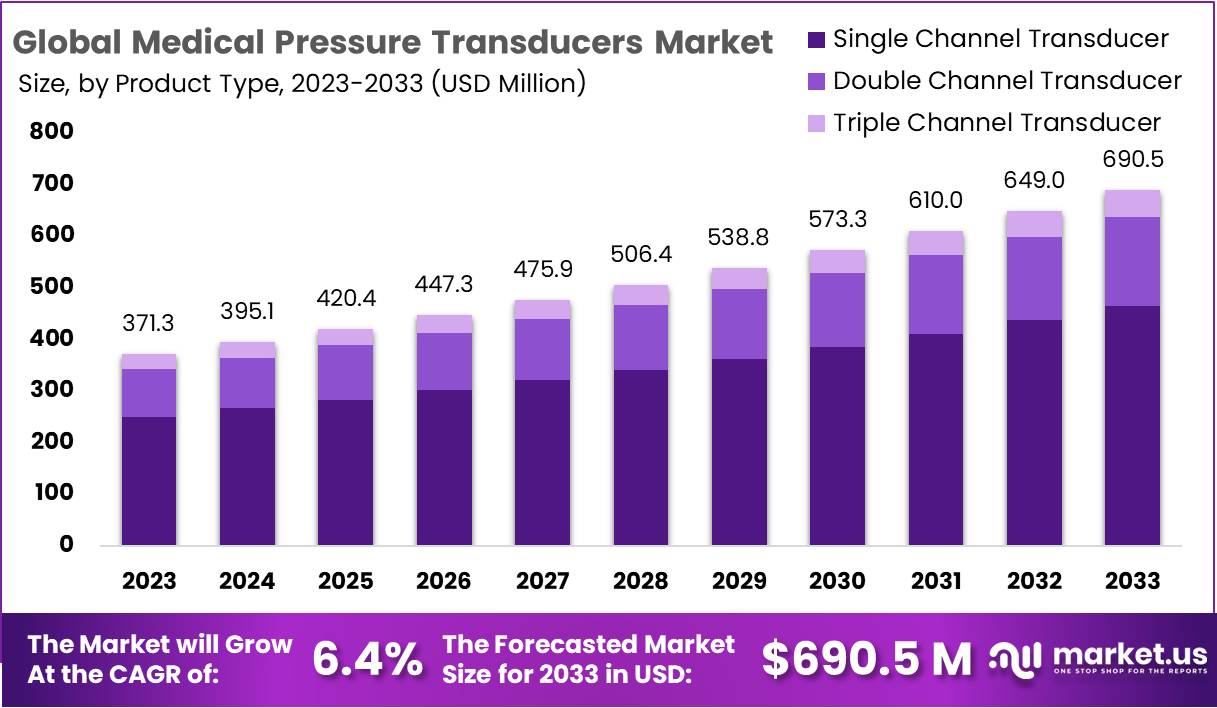Introduction
The Medical Pressure Transducers Market is poised for significant expansion, with a forecasted growth from USD 371.3 million in 2023 to approximately USD 690.5 million by 2033, marking a Compound Annual Growth Rate (CAGR) of 6.4%. This growth trajectory is fueled by advancements in microelectromechanical systems (MEMS) technology, which enhance the performance of pressure sensors. These sensors are now more sensitive, accurate, and compact, making them suitable for a range of medical applications, including vital signs monitoring in wearable health devices.
The demand for these devices is surging, driven by the growing need for continuous health monitoring amidst an increase in chronic diseases. Wearable and flexible pressure sensors facilitate real-time tracking of critical health metrics such as blood pressure and heart rate, benefitting both patients and healthcare providers. This evolution in sensor technology not only improves patient compliance but also enriches overall health outcomes by providing precise and timely data.
Recent strategic developments further bolster the market’s growth. For instance, in December 2023, Abbott and Roche formed a strategic partnership to develop advanced blood pressure monitoring solutions incorporating pressure transducers. This collaboration aims to harness Abbott’s expertise in pressure transduction and Roche’s capabilities in diagnostics and analytics to create innovative, real-time monitoring systems for better cardiovascular disease management.
Additionally, significant acquisitions are shaping the industry landscape. In October 2023, Cardinal Health acquired Smiths Medical for $1.44 billion, aiming to strengthen its position in critical care through enhanced patient care solutions, particularly leveraging Smiths Medical’s pressure transducers. Another notable development occurred in September 2023 when BD introduced Bard, a next-generation disposable pressure transducer designed for precise and sterile invasive hemodynamic monitoring, emphasizing improvements in accuracy and durability.
Moreover, the merger between Teledyne Technologies and Viventium Medical in July 2023 led to the formation of Teledyne Viventium, a combined entity focused on innovating medical pressure measurement technologies. This merger is set to expedite the development and market introduction of advanced solutions for respiratory monitors, infusion pumps, and other critical care applications, promising enhanced patient care through cutting-edge technology. These strategic moves underline the sector’s dynamic progress and the ongoing commitment to technological innovation and market expansion.

Key Takeaways
- The Medical Pressure Transducers Market is expected to grow by 6.4% annually, reaching USD 690.5 million by 2033 from USD 371.3 million in 2023.
- These devices are crucial for real-time monitoring of physiological pressures, essential in surgical and critical care settings.
- In 2023, the Single Channel Transducer segment dominated, accounting for over 67.4% of the market, favored for its simplicity and cost-effectiveness.
- Blood Pressure Monitoring is the leading application, holding more than 37.3% of the market share.
- Market growth is fueled by the rising prevalence of arterial hypertension and the demand for disposable transducers.
- Challenges include the lack of reimbursements in developing areas, competition from low-cost suppliers, and a shortage of skilled healthcare professionals.
- North America led the market in 2023, with over 40.1% share, supported by advanced healthcare infrastructure and high chronic disease prevalence.
- Opportunities are increasing as disposable incomes and healthcare spending rise in developing countries.
- Technological advancements include a trend towards mergers and acquisitions, and a shift to digital transducers for better connectivity.
- Market dynamics are shaped by both challenges like skilled labor shortages and opportunities in telehealth integration.
Emerging Trends
- Miniaturization and MEMS Technology: The trend towards smaller devices in medical technology is significant, especially with the adoption of Micro-Electro-Mechanical Systems (MEMS). These systems enable the creation of more compact and efficient capacitive pressure transducers. As a result, production costs have decreased, making these devices more economical to manufacture and easier to integrate into various medical applications. This miniaturization not only enhances device portability but also expands their functionality in healthcare settings.
- Integration into Wearable Devices: Technological advances have led to the development of flexible and conformal sensors that can be integrated into wearable medical devices. This integration is a breakthrough in patient care, allowing for the continuous monitoring of critical physiological parameters such as blood pressure and respiratory rates. The ability to track these parameters in real-time significantly improves patient monitoring and management, making care more proactive and responsive.
- Enhanced Sensitivity and Accuracy: There is a focused effort within the medical community to enhance the sensitivity and accuracy of pressure sensors. Researchers are developing high-performance MEMS pressure sensors that not only offer greater sensitivity and precision but also the capability to integrate multiple parameters. These improvements aim to provide more detailed and reliable data, supporting better diagnostic and treatment options for patients.
Use Cases
- Miniaturization and MEMS Technology: The rise of Micro-Electro-Mechanical Systems (MEMS) technology has revolutionized the production of capacitive pressure transducers. These smaller, more efficient devices have slashed production costs and broadened their application range. Miniaturization not only optimizes device functionality but also paves the way for broader integration across various medical technologies, improving both accessibility and convenience.
- Integration into Wearable Devices: Developments in flexible and conformal sensors have paved the way for integrating pressure transducers into wearable medical devices. This advancement supports the continuous monitoring of critical physiological parameters, such as blood pressure and respiratory rates. As a result, these devices play a crucial role in advancing patient care by providing real-time health monitoring, which can lead to prompt medical interventions.
- Enhanced Sensitivity and Accuracy: There is a continual push to enhance the sensitivity and accuracy of medical pressure sensors. Researchers are developing high-performance MEMS pressure sensors that offer superior sensitivity and accuracy. These sensors are capable of integrating multiple parameters, which significantly contributes to their utility in various medical scenarios. By improving these aspects, medical professionals can obtain more precise readings, leading to better patient outcomes.
Regional Analysis
In 2023, North America led the Medical Pressure Transducers Market, holding over 40.1% market share. The region’s market value reached USD 148.8 million, highlighting its strong presence. This dominance stems from an advanced healthcare infrastructure and cutting-edge medical technologies. A growing elderly population and high chronic disease prevalence further fuel demand for accurate pressure monitoring devices. These factors contribute to North America’s leadership in adopting medical pressure transducers, making it the largest revenue-generating region in the global market.
The United States plays a pivotal role in North America’s dominance. The country has a well-established healthcare system and a strong regulatory framework, allowing quick adoption of innovative medical devices. Additionally, major market players are based in the U.S., driving technological advancements and expanding the product pipeline. This favorable environment encourages the development and commercialization of next-generation medical pressure transducers. The increasing emphasis on patient safety and precision monitoring further accelerates market growth in the region.
Europe follows North America in market share, supported by its robust healthcare infrastructure and a shift towards patient-centric care. Governments in the region are investing in advanced medical technologies, boosting market growth. However, cost constraints and regulatory compliance issues pose challenges. Meanwhile, Asia-Pacific exhibits high growth potential, driven by increasing healthcare spending and a rising patient population. However, varying healthcare standards and regulatory complexities across countries slow market expansion. These factors create both opportunities and barriers in the region.
Latin America and the Middle East & Africa hold smaller market shares but offer untapped potential. Healthcare investments in these regions are rising, improving medical accessibility and infrastructure. Governments are working to enhance healthcare services, increasing demand for medical pressure transducers. Although challenges like limited resources and regulatory hurdles exist, the market is poised for gradual growth. Expanding healthcare awareness, coupled with technological adoption, will drive market penetration in the coming years, making these regions attractive for future investments.
Conclusion
The Medical Pressure Transducers Market is experiencing steady growth, driven by advancements in sensor technology, increasing demand for real-time health monitoring, and rising chronic disease cases. Wearable medical devices and miniaturized sensors are transforming patient care by enabling continuous and accurate monitoring of vital health parameters. Strategic partnerships, acquisitions, and mergers are strengthening industry competitiveness, leading to innovation and improved healthcare solutions. North America leads the market due to its advanced healthcare infrastructure, while Europe and Asia-Pacific show strong growth potential. Challenges such as regulatory hurdles and skilled labor shortages persist, but technological advancements and rising healthcare investments continue to create opportunities, shaping the future of medical pressure transducers.
Discuss your needs with our analyst
Please share your requirements with more details so our analyst can check if they can solve your problem(s)



